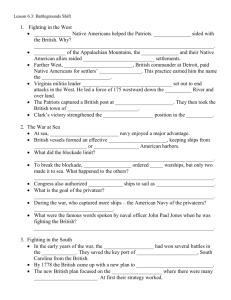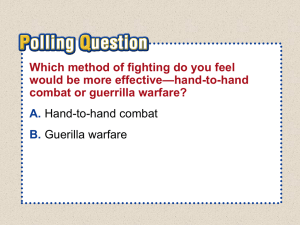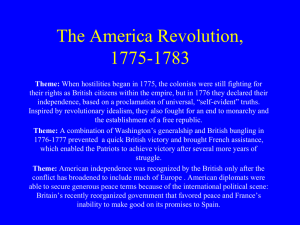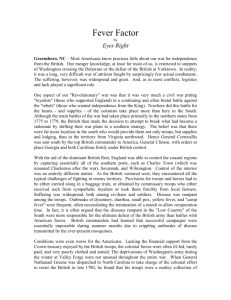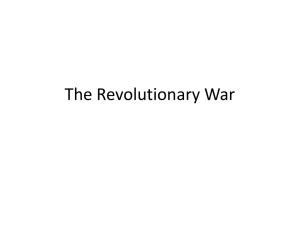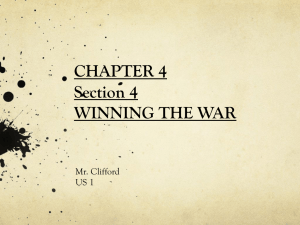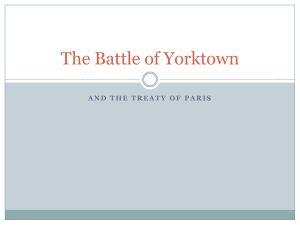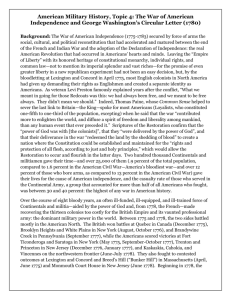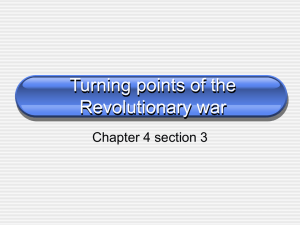The War Moves West and South
advertisement
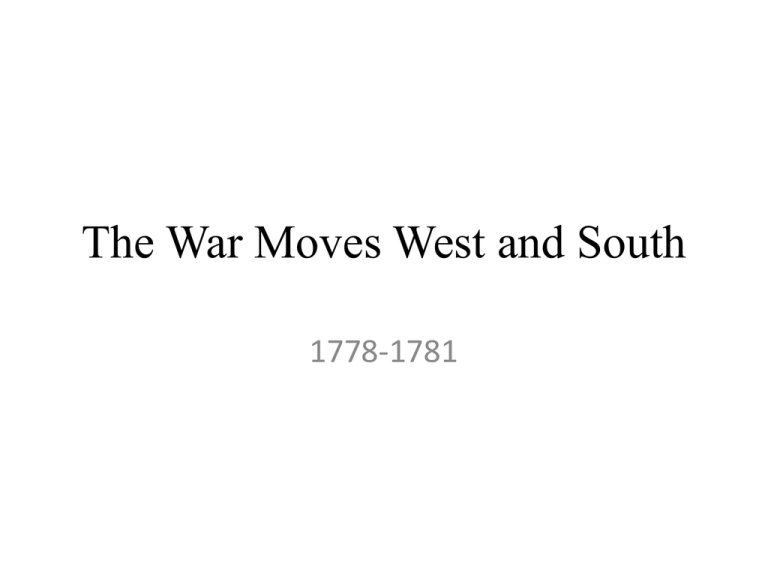
The War Moves West and South 1778-1781 War in the West • Objectives • How the war involved Native Americans. British Strategy British would use their Indian allies of the frontier to prevent westward expansion of the Americans. George Rogers Clark Clark led an expedition into the Northwest Territory to capture British posts and claim lands for his home Virginia. British Frontier Fighters Henry Hamilton Joseph Brandt The “Hair Buyer” Mohawk Chief Clark’s Victories Vincennes February 23, 1779 Kaskaskia Captured July 4, 1778 Self Check • Why did the Native Americans of the West side with the British? Glory at Sea • Objectives • How privateers help the Patriot cause • Who was America’s naval hero Privateers Merchant vessels armed. Hired by governments to harass enemy shipping.. Today we would call them pirates. John Paul Jones Commander of the Ranger. He was then given command of a French ship. He named it Bonhomme Richard to honor Benjamin Franklin.. Attacked a British convoy and fought the Serapis. When asked to surrender he replies, “I have not yet begun to fight!” Self Check • Why were privateers so important to the Patriot cause? • How did John Paul Jones become such a national hero? Struggles in the South • Objectives • Why the British shift their war plans to the South. • Why their style of fighting after initial success failed in the South. British Strategy With the entrance of France into the war. Great Britain had to reassess its strategy. It now had to divert troops and ships from North America to protect its other colonies. Monmouth June 28, 1778. As British are retreating across New Jersey from Philadelphia to New York. Washington saw a chance to attack with his von Steuben trained army. Key Figures at Monmouth Charles Lee Failed to carry out orders. Molly Pitcher Took her husbands place. Savannah GA To protect their interests in the West Indies, the British needed ports. First was Savannah GA. Sir Henry Clinton led an expedition that captured the city December 29, 1778 Charleston S.C. American forces defended by Benjamin Lincoln, came under siege from Clinton beginning April 1, 1780. Cut off from all supplies, Lincoln surrendered May 12, 1780. The 5,000 prisoners taken was the largest American surrender of the war. Camden General Horatio Gates, the hero of Saratoga, took command of the Southern Army July 25, 1780. He attacked the British commanded by Charles Cornwallis August 16, 1780. The British soundly defeated Gates. Gates was one of the first officers to retreat. His fame gained at Saratoga was lost at Camden. Banastre Tarleton Feared British cavalry officer commander of a group known as The Tory Legion. Earned the nickname “Butcher”. Guerilla Warfare Using knowledge of local terrain, Patriots adopted hit and run tactics. Francis Marion, “The Swamp Fox”, Thomas Pinckney, Thomas Sumter, Andrew Pickens were some of the leaders. Spanish Help Bernardo de Galvez becomes governor of Louisiana January 1777. Helped keep Mississippi River open to supply Clark and his men. Drove the British from Natchez, Mobile, and Pensacola FL. Kings Mountain October 7, 1780, Kings Mountain North Carolina. Patrick Ferguson commanded 1,000 loyalists against Patriots. Firing rifles, the accuracy of the weapon led to a decisive victory. The outcome convinced many Americans in the south to become Patriots. Ironically, Ferguson, inventor of a rifle, fell to the accuracy of a Patriot. Nathanael Greene After Gates was defeated at Camden, Nathanael Greene was placed in command of the Southern Army. He adopted the hit and run tactics of the local guerilla bands. Cowpens January 17, 1781, American forces led by Daniel Morgan met Tarleton’s Legion at The Cowpens, South Carolina. In the ensuing battle, 110 British are killed, 830 are captured. American casualties: 12 dead, 61 wounded. Guilford Courthouse March 15, 1781, near present day Greensboro, North Carolina, Americans led by Nathanael Greene met the British commanded by Charles Cornwallis. At the height of the battle, Cornwallis orders his cannon to fire on friend and foe alike. His army suffers heavy losses: 184 killed, 780 wounded or missing. He then retreats to Virginia. Retreat to Yorktown The British Army retreats to Yorktown on the peninsula between the James and York rivers. Here American forces led by Anthony Wayne, von Steuben, and Lafayette have Cornwallis trapped. But the Americans are too weak to attack. Self Check • Why did the British focus their strategy on controlling the South? • How were the Americans able to overcome the superior British numbers, equipment, and experienced leadership in the South
